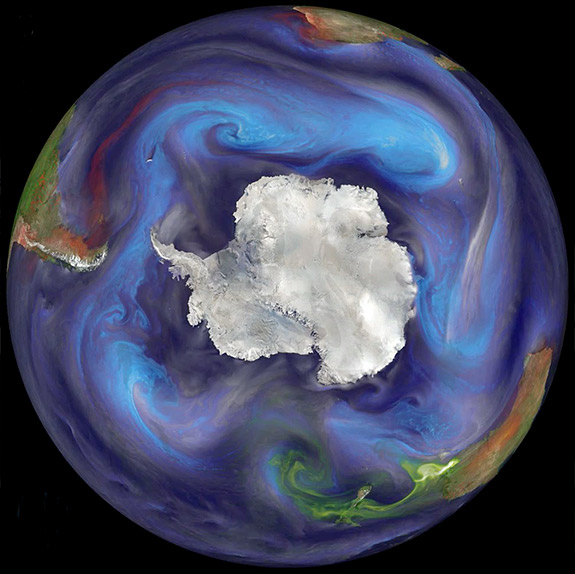In Australia the arrival of Europeans profoundly effected the biology of the continent through introduction of non-native species that are reproducing and invading at an unprecedented rate. Australian biologists call it “extinction calamity” since the continent has lost one in ten of its native mammals species in the past 200 years. The effects of climate change is also evident with severe droughts and wild fires. A large fraction of Australian vegetation is serotinous that is adapted to disperse their seeds when triggered by fire. Cane toads are one of the prime example of catastrophic species introduction with unintended consequences. Decades after their intentional release cane toads continue to spread over the continent.
Southern Ocean is quite special for it is the only region on our planet where ocean currents can flow without being obstructed by land masses. The Antarctic Circumpolar Current forms a cold shield around Antarctica isolating the continent from warm waters.
The image above shows a plume of dust from South America bringing iron (orange to red) to the Subantarctic zone in the northern part of the Southern Ocean on December 30, 2006. Blue regions show sea salt. Green to yellow regions show organic and black carbon. Sulfates with ash are indicated in colors ranging from brown to white. Proximity of Australia to Southern Ocean allows researchers to experiment on a curious natural interaction that has been observed in other parts of the world as well. Antarctic Circumpolar Current is the strongest on the planet and therefore has a very high rate of interaction with the atmosphere. Winds that blow off South America, South Africa and Australia end up in the Southern Ocean. During the last ice age, an increase in the supply of dust to the region fertilized the ocean, stimulating marine productivity and causing nitrogen to be drawn down to low levels. The associated increase in the efficiency of carbon sequestration into the deep ocean can explain part of the atmospheric CO2 decrease observed during the last ice age.
Strong interaction between iron rich desert dust and the oceans brings the prospects of geoengineering. Can we mimic what occurs naturally to capture the unacceptable amounts of carbon being emitted to the atmosphere? This is not a simple feat. Calculations show that it would require 100 large ships operating all year to distribute 1bn tonnes of the mineral olivine
Iron rich dust blown from worlds deserts into aquatic environments is a well known fact. Saharan dust can fertilize nutrient poor Mediterranean waters (see the NASA image below). Saharan dust also travels across the Atlantic ocean and rains over the Amazon forests. The dust plumes can suppress hurricane formation over the Atlantic. This strong natural force can be used to trap carbon in the air by microorganisms. Worlds oceans continue to absorb the excess carbon and are becoming more and more acidic. Ocean acidification is an extremely important problem with dire consequences. Many marine microorganisms at the bottom of the food chain cannot build shells under acidic conditions and this may lead to collapse of the entire food webs.




0 Comments
You can be the first one to leave a comment.